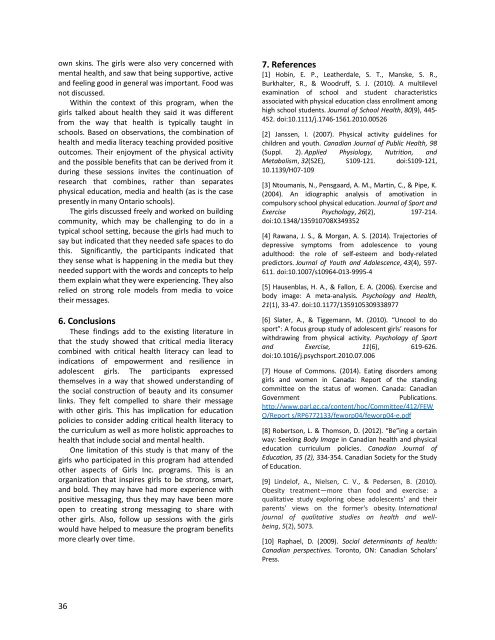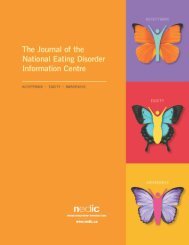NEDIC Conference Journal 2018
Create successful ePaper yourself
Turn your PDF publications into a flip-book with our unique Google optimized e-Paper software.
own skins. The girls were also very concerned with<br />
mental health, and saw that being supportive, active<br />
and feeling good in general was important. Food was<br />
not discussed.<br />
Within the context of this program, when the<br />
girls talked about health they said it was different<br />
from the way that health is typically taught in<br />
schools. Based on observations, the combination of<br />
health and media literacy teaching provided positive<br />
outcomes. Their enjoyment of the physical activity<br />
and the possible benefits that can be derived from it<br />
during these sessions invites the continuation of<br />
research that combines, rather than separates<br />
physical education, media and health (as is the case<br />
presently in many Ontario schools).<br />
The girls discussed freely and worked on building<br />
community, which may be challenging to do in a<br />
typical school setting, because the girls had much to<br />
say but indicated that they needed safe spaces to do<br />
this. Significantly, the participants indicated that<br />
they sense what is happening in the media but they<br />
needed support with the words and concepts to help<br />
them explain what they were experiencing. They also<br />
relied on strong role models from media to voice<br />
their messages.<br />
6. Conclusions<br />
These findings add to the existing literature in<br />
that the study showed that critical media literacy<br />
combined with critical health literacy can lead to<br />
indications of empowerment and resilience in<br />
adolescent girls. The participants expressed<br />
themselves in a way that showed understanding of<br />
the social construction of beauty and its consumer<br />
links. They felt compelled to share their message<br />
with other girls. This has implication for education<br />
policies to consider adding critical health literacy to<br />
the curriculum as well as more holistic approaches to<br />
health that include social and mental health.<br />
One limitation of this study is that many of the<br />
girls who participated in this program had attended<br />
other aspects of Girls Inc. programs. This is an<br />
organization that inspires girls to be strong, smart,<br />
and bold. They may have had more experience with<br />
positive messaging, thus they may have been more<br />
open to creating strong messaging to share with<br />
other girls. Also, follow up sessions with the girls<br />
would have helped to measure the program benefits<br />
more clearly over time.<br />
7. References<br />
[1] Hobin, E. P., Leatherdale, S. T., Manske, S. R.,<br />
Burkhalter, R., & Woodruff, S. J. (2010). A multilevel<br />
examination of school and student characteristics<br />
associated with physical education class enrollment among<br />
high school students. <strong>Journal</strong> of School Health, 80(9), 445-<br />
452. doi:10.1111/j.1746-1561.2010.00526<br />
[2] Janssen, I. (2007). Physical activity guidelines for<br />
children and youth. Canadian <strong>Journal</strong> of Public Health, 98<br />
(Suppl. 2). Applied Physiology, Nutrition, and<br />
Metabolism, 32(S2E), S109-121. doi:S109-121,<br />
10.1139/H07-109<br />
[3] Ntoumanis, N., Pensgaard, A. M., Martin, C., & Pipe, K.<br />
(2004). An idiographic analysis of amotivation in<br />
compulsory school physical education. <strong>Journal</strong> of Sport and<br />
Exercise Psychology, 26(2), 197-214.<br />
doi:10.1348/135910708X349352<br />
[4] Rawana, J. S., & Morgan, A. S. (2014). Trajectories of<br />
depressive symptoms from adolescence to young<br />
adulthood: the role of self-esteem and body-related<br />
predictors. <strong>Journal</strong> of Youth and Adolescence, 43(4), 597-<br />
611. doi:10.1007/s10964-013-9995-4<br />
[5] Hausenblas, H. A., & Fallon, E. A. (2006). Exercise and<br />
body image: A meta-analysis. Psychology and Health,<br />
21(1), 33-47. doi:10.1177/1359105309338977<br />
[6] Slater, A., & Tiggemann, M. (2010). “Uncool to do<br />
sport”: A focus group study of adolescent girls’ reasons for<br />
withdrawing from physical activity. Psychology of Sport<br />
and Exercise, 11(6), 619-626.<br />
doi:10.1016/j.psychsport.2010.07.006<br />
[7] House of Commons. (2014). Eating disorders among<br />
girls and women in Canada: Report of the standing<br />
committee on the status of women. Canada: Canadian<br />
Government<br />
Publications.<br />
http://www.parl.gc.ca/content/hoc/Committee/412/FEW<br />
O/Report s/RP6772133/feworp04/feworp04-e.pdf<br />
[8] Robertson, L. & Thomson, D. (2012). “Be”ing a certain<br />
way: Seeking Body Image in Canadian health and physical<br />
education curriculum policies. Canadian <strong>Journal</strong> of<br />
Education, 35 (2), 334-354. Canadian Society for the Study<br />
of Education.<br />
[9] Lindelof, A., Nielsen, C. V., & Pedersen, B. (2010).<br />
Obesity treatment—more than food and exercise: a<br />
qualitative study exploring obese adolescents’ and their<br />
parents’ views on the former's obesity. International<br />
journal of qualitative studies on health and wellbeing,<br />
5(2), 5073.<br />
[10] Raphael, D. (2009). Social determinants of health:<br />
Canadian perspectives. Toronto, ON: Canadian Scholars’<br />
Press.<br />
36




